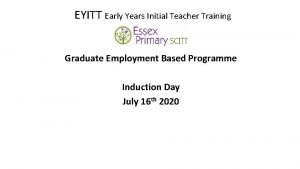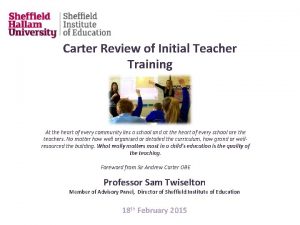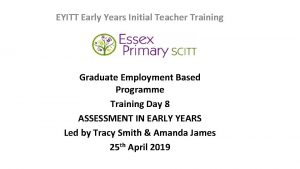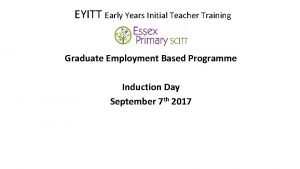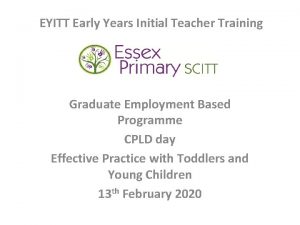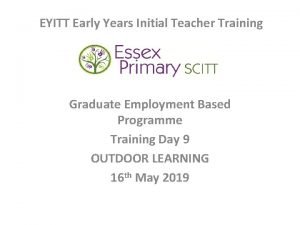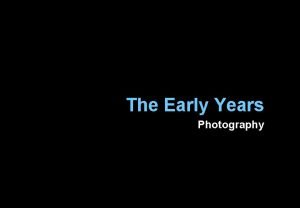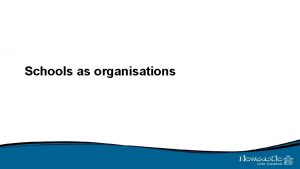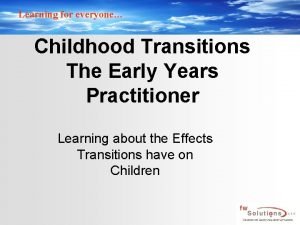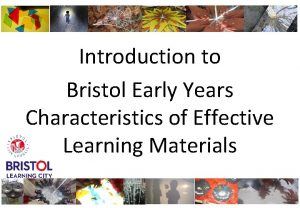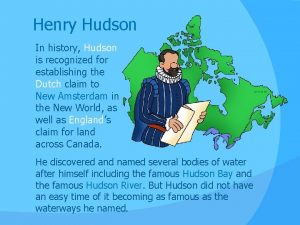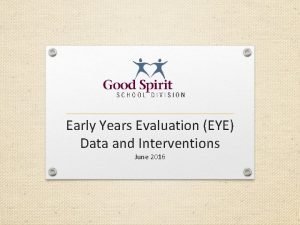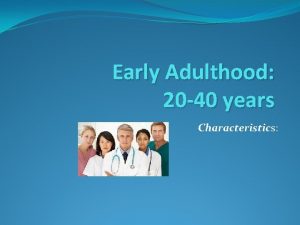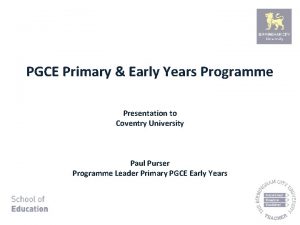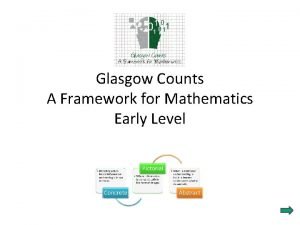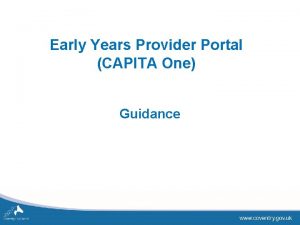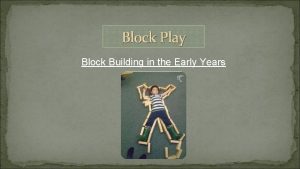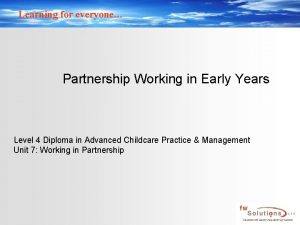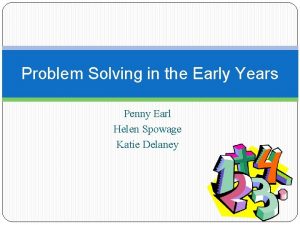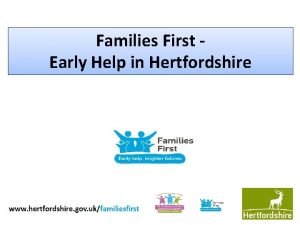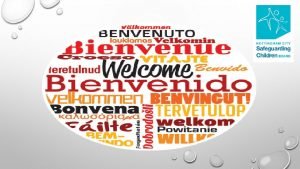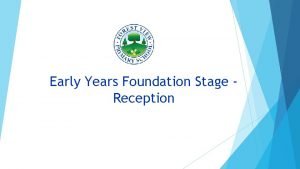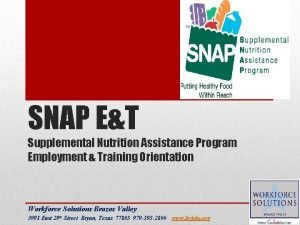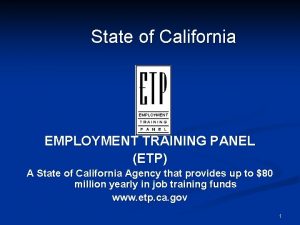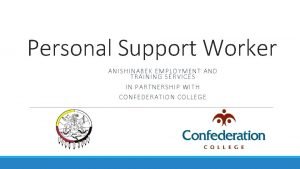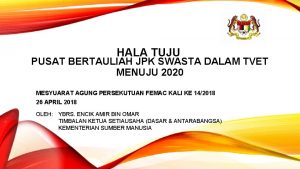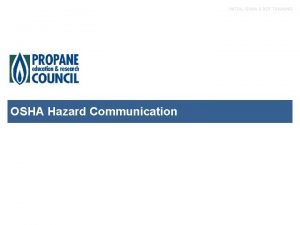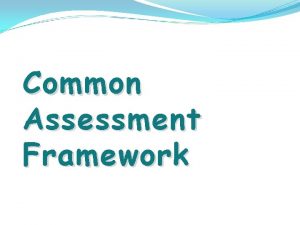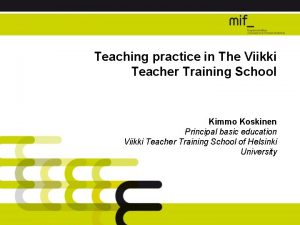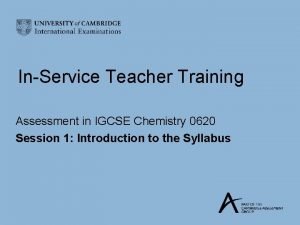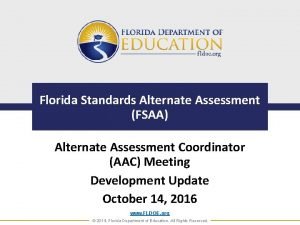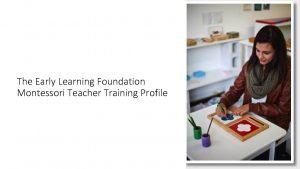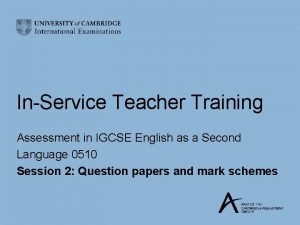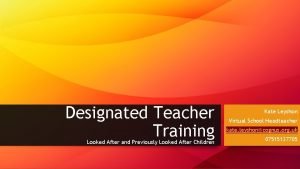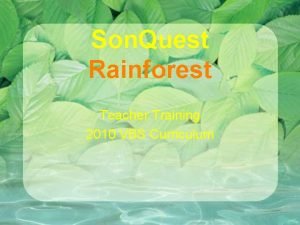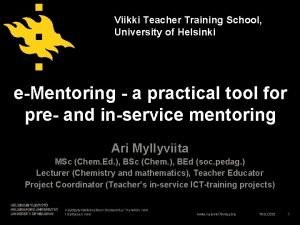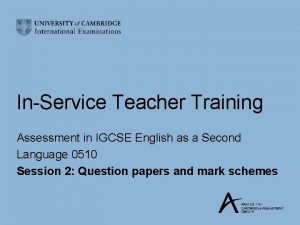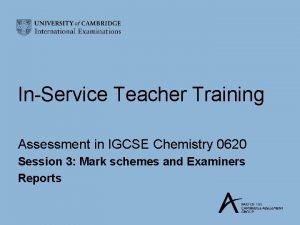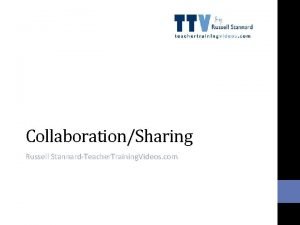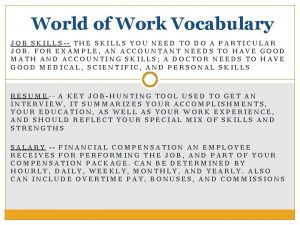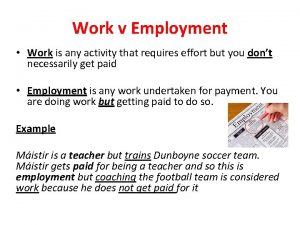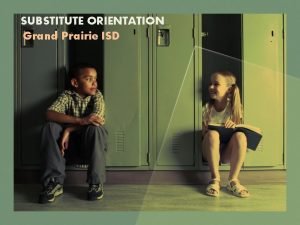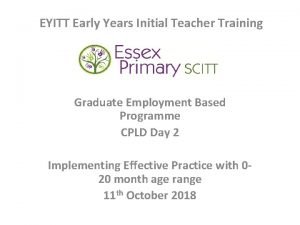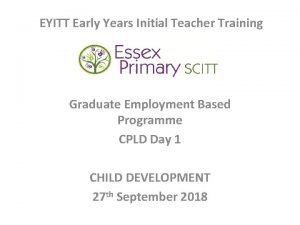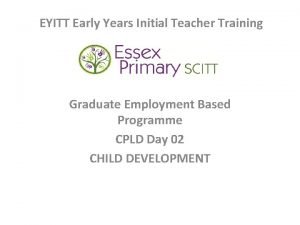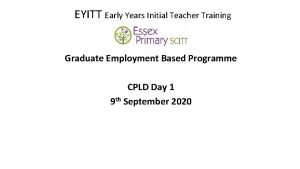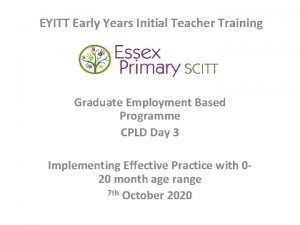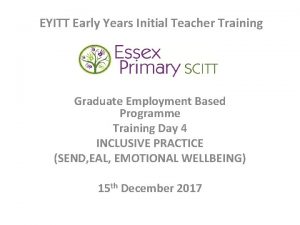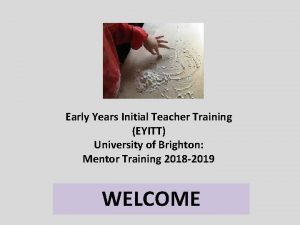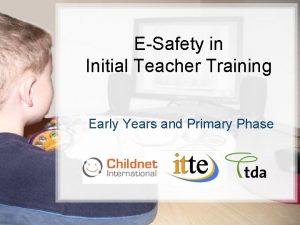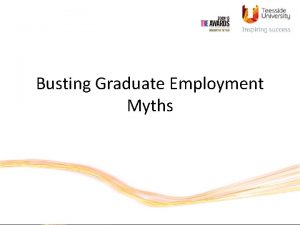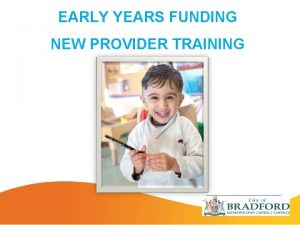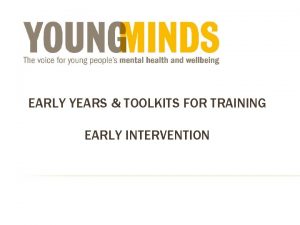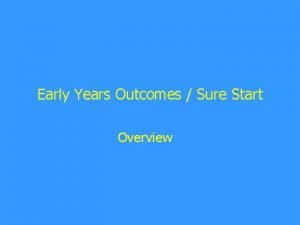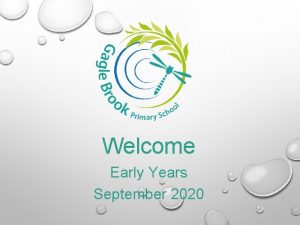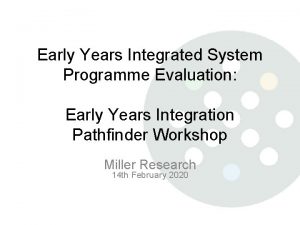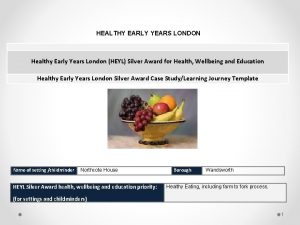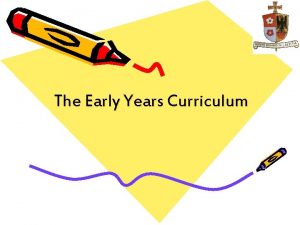EYITT Early Years Initial Teacher Training Graduate Employment



































































- Slides: 67

EYITT Early Years Initial Teacher Training Graduate Employment Based Programme Training Day 8 ASSESSMENT IN EARLY YEARS Led by Tracy Smith & Amanda James 25 th April 2019

Covered in this session • Amplification of the sub-standards within standard 6 and related to practice and evidence • Parental interaction • Statutory assessment requirements in the EYFS • Formative assessment in action • Assessment and Fundamental British Values

6. 1 Understand lead assessment within the framework of the EYFS framework, including statutory assessment requirements Amplifications Early Years Teachers will… 6. 1 Recognise and lead practitioners understanding of formative and summative assessments, specifically the progress checks at age 2 and the Early Years Foundation Stage Profile. Early Years Teachers ensure practitioners are supported in completing paperwork which is absolutely necessary to promote children’s learning and development and in partnership with parents and/or carers, and any relevant professionals.

Principles underpinning assessment The principles that should underpin assessment of young children’s learning and development are as follows. • Reliable and accurate assessment should be based primarily on the practitioner’s knowledge of the child, gained predominantly from observation and interaction in a range of daily activities and events. • Well-thought-through provision that enables each child to demonstrate their learning and development fully. • Practitioners should be looking for evidence of ‘embedded learning’ – this is identified by assessing what a child can do consistently and independently in a range of everyday situations. • An effective assessment should present a holistic view of a child’s learning and development. • Accurate assessments need to include contributions from a range of perspectives including the child (whenever possible), their parents and other relevant adults. 4

Good assessment practice. . . • Includes the child’s perspective and the views of those who know the child. • Is based on holistic observations of the child by adults who can tune into the variety of ways a child demonstrates knowledge skills and understanding. • Is accurate and reliable when based on child initiated/independent activity in a variety of contexts. “Assessment should not entail prolonged breaks from interaction with children nor require excessive paper work Paperwork should be limited to that which is absolutely necessary to promote children’s successful learning and development” 5 Taken from EYFS document

Formative and Summative Assessment Formative assessment Summative assessment . . refers to a wide variety of methods that Teachers use to conduct in-process evaluations of student comprehension, learning needs and academic progress during a lesson, unit or course… In other words, formative assessments are for learning, while summative assessments are of learning. . . usually takes place after pupils have completed a unit of work or modules at the end of each term and/or year. The information it gives indicates progress and achievement, usually in grade-related or numerical terms. It’s the more formal summing-up of a pupil’s progress.

Progress check at age two (summative) Statutory requirement • The revised EYFS introduces a requirement for providers to review children’s progress when a child is aged between two and three. A short written summary must be provided to parents or carers, highlighting achievements and areas in which extra support might be needed, and describing how the provider will address any issues Possible evidence • a redacted copy with the annotation detailing implications for your practice • Transcript of an interview with a colleague • Reflective log around feedback from a parent • Plan detailing next steps for your practice and the child • Advice given to a colleague around their practice with the child/parents or carers • Others?

End of EYFS assessment (summative) • Reduction to 17 Early Learning Goals • Change from EYFS profile points – emerging, expected, exceeding

Every setting will keep their own form of records -Observation files -Dm grids -Profile sheets -Learning Journey -Target Tracker 9

What is observational assessment? Observational assessment involves watching, listening and noting what children say and do as they play together, interact with adults and engage in everyday activities and experiences. From this you will be able to build up an understanding of individual children by seeing how they demonstrate their specific knowledge, skills and understanding. Each child will be different in this respect as everyone has their own unique way of approaching and building their learning. Observational assessment is the key to understanding what children really know and can do, and it is the most reliable way of building up an accurate picture of a child’s development and learning. How and when observations are made will vary depending on the circumstances, the child and the type of activity. Although some observations may be planned, there will be others that are more spontaneous and capture an important moment or event. The key to capturing these moments is to know the children well and to be aware of the sorts of things that are likely to spark their imagination. This also supports your planning, which will come from previous observations of young children’s interests and fascinations.

A holistic approach to assessment is necessary in order to reflect accurately the nature of children’s development and to acknowledge the interrelationship between different aspects of learning. 11

Evidence of attainment The holistic nature of young children’s learning means that observations of everyday activities will provide evidence of attainment across many different areas of learning. This is where a thorough knowledge of the content of the EYFS Learning and Development Framework is essential. It is only through this that practitioners can be fully tuned-in to all the learning opportunities that present themselves in every setting on a daily basis. The core skill practitioners need to develop is an appreciation of what is important and meaningful for any one child within the vast range of possible ‘observation opportunities’ available.

Formative assessment in action Selfregulated learners Mastery, including process Reflective habits of mind Feedback Patterns of thought

Formative assessment in action Questioning Feedback Success criteria Next steps Planning Enabling systems and pedagogies Space and time, including observation Peer Assisted Learning

Formative assessment in action Classroom Participants (co-agency) Assessment Literacy (accommodat ion of need) Enabling People Parents/ Community Curriculum Leadership

Assessment of learning behaviours • Checklist of Independent Learning Development (CHILD) - the work of David Whitebread et al. looks at ‘Emotional; Prosocial; Cognitive; Motivational’ • The Analysing Children’s Creative Thinking (ACCT) framework. (Hargreaves)

Purpose

Visible learning “Visible learning means an enhanced role for teachers as they become evaluators of their own teaching. According to John Hattie, Visible Learning and Teaching occurs when teachers see learning through the eyes of students and help them become their own teachers” Visible Learning. Org Practical strategies (indoor and outdoor): • Annotated photographs of processes to provide success criteria • Labels and captions • Photographs of possible resources to use in an area • Scrapbooks/folders • Brainstorming/concept mapping • Learning boards • Learning talk • Learning = next step planning • Child leading the learning

According to Hattie….

Unpacking metacognition • Leading learning • Emotional intelligence • Attitudes • Resourceful • Neurons • Inquisitive • Neighbours • Growth mindset amanda. james 1514@gmail. com Thinking Spaces. . . .

Growth mindset

Into the classroom…… • Using either the assessment in action or an area within the Checklist of Independent Learning and Development document, observe practice in the classrooms • What did you notice about the visible learning employed? • Was there evidence of self-regulatiuon? How did the teachers support this? • Feedback

Using a well-thought-through pedagogical approach It is essential that the approach, enables each child to demonstrate and build their learning and development. Effective observational assessment, which involves noticing children’s interests, skills and knowledge, should be used to plan relevant and motivating learning experiences for each child. When children have access to a rich learning environment it provides them with the opportunities and conditions in which they can flourish in all aspects of their development. As part of the audit of the effectiveness of your assessment procedures you may want to consider your understanding of child development, including both the biological and cultural aspects, and how this impacts on the way you support children’s learning in your setting how well your approach to planning ensures a wide range of relevant, motivating, flexible and interesting opportunities for children how effectively your environment facilitates and encourages successful learning by all children in your setting, e. g. boys and girls, children with additional needs, children for whom English is not their home language or children who learn best when out of doors. how well all staff members understand the EYFS Framework and the principles behind the setting’s observation and assessment policy the importance of high-quality adult interaction that is sensitive and adaptive to the needs of individual children. the importance of quality dialogue and Sustained Shared Thinking practices The implementation of a successful observation and assessment policy not only supports individual children’s continuing learning and development, but it also provides vital information to share with parents and with colleagues who may have responsibility for supporting the next stage in a child’s learning journey. Identify where you can lead on one of these elements

Formative assessment in action, non-verbal Activity • Form a group of 3 where possible • One of you is the participant • Two of you are observers • The participant must construct a free-standing model using 3 pieces of paper • The participant must not speak • Both observers independently record what they are assessing from their observation • When the model is complete, the observers compare notes – are they the same? • Feedback to the participant – did the observers accurately assess the participants thought processes From their observed actions? • As practitioners, what would your top 3 next step priorities be to sufficiently support the participants progress? Why?

Does each child know their learning is valued?

6. 2 Engage effectively with parents and/or carers and other professionals in the on-going assessment and provision for each child. • Amplifications • Early Years Teachers will… • 6. 2 Engage sensitively with parents/carers, providing regular opportunities to work together to review their child’s progress and plan how best to support the next steps of learning and development. Early Years Teachers discuss with parents/carers how to further support their child’s wellbeing, learning and development at home. They understand the importance of working with other professionals to address any emerging concerns and develop a plan to support the child’s learning and development needs.

Physical Activity = Cognitive Growth • Children need around 60 minutes physical activity per day, most of which should be aerobic ( WHO) • For younger children bone loading activities such as running , jumping, turning , skipping games • Promotes: Healthy musculoskeletal tissues • Healthy Cardio vascular system • Maintaining health body weight • Prevents anxiety and depression

Physical activities Movement provides the foundation for a range of learning Social – shaking hands; helping set up for snack time; sign language Intellectual – action songs that support memory and language Emotional – confidence when babies can reach/grasp/clap hands; sign language (linked to the development of Theory of Mind) Cognition – movement involves planning, sequencing, co-ordination, repetition • • Chasing games Tummy time Dancing Move like animals – animal walk! Fly paper aeroplanes Fly Kites Climb Trees! • • Jungle boogie Carrying things/different weights Everyday activities Carrying washing Cleaning the car Doing house work Gardening.

The vestibular sense (sense of balance) Activities that stimulate this system • Hanging upside down • Spinning • Swinging • Tumbling • Falling • Rolling • Sliding Link to • Co-regulation and selfregulation (learning to take calculated risks) • Language development • Mathematical concepts • Early writing (particularly on a horizontal surface)

Proprioceptive sense (awareness of your body in relation to the environment) Activities that stimulate this system • • • Applying pressure Tummy crawling Crawling on hands and knees Climbing Jumping Tug of war Hanging by hands and arms Rough and tumble Running Swimming Carrying heavy objects to encourage muscle tone Link to • Co-ordination • Planning and goal-directed tasks • Orientation • Decision-making • Causal effect • Self-regulation • Personal limits • Strength • Self-awareness • Self-esteem

Brainstorming opportunity! • What advice and practical strategies have you given to parents/carers in relation to specific areas of learning development? • How?

Lunch

6. 3 Give regular feedback to children and parents and/or carers to help children progress towards their goals. Amplifications Early Years Teachers will… • Ensure time is allocated to parents and/or carers to discuss children’s learning and development on a regular basis, and to promote the two way sharing of information to help children progress towards their goals. Early Years Teachers can identify a range of methods to share information with parents and use these as appropriate for each family’s individual needs and circumstances.

This is a major talking point within EYFS and always has been. Children will automatically look to an adult or will alter how they are playing to suit what they think the adult wants to see! How can we interact effectively within children’s play WITHOUT leading or taking over the play? It is about - strategic intervention – when to approach - sustained shared thinking – quality dialogue, including questioning - making it common place – children are used to it 34

Supporting parents to give regular feedback As well as assessment policies and procedures, you can support parents in giving regular feedback to children. The importance of effective dialogue: • Giving regular feedback to children effective questioning; narrating elements of play; providing challenge through next steps; possibility thinking (creativity - posing questions ; making connections ; being imaginative ; exploring options; engaging in critical reflection / evaluation); paired reflection; scaffolding • Four levels of questioning 1. summarising/definition/fact (‘Who did. . ? ’); 2. analysis/interpretation questions (‘How did…happen? ’); 3. hypothesis/prediction questions (‘If…occurs, then what would happen? ’); 4. critical analysis/evaluation/opinion (‘Is this good/bad? Why? ’) • Growth mindset fixed/growth (Dr. Carol Dweck) • Active listening ‘look, listen, note’; interacting/interfering; scaffolding (through interaction and resourcing) • Hypothesis testing from a young age ‘What would happen if…? ’ ‘I think that because…’

Vygotsky and the Zone of Proximinal Development • “the distance between the actual developmental level as determined by independent problem solving and the level of potential development as determined through problem-solving under adult guidance, or in collaboration with more capable peers” (Vygotsky 1978)

Wood and Middleton (1975) - Scaffolding The following study provides empirical support both the concept of scaffolding and the ZPD. • Procedure: 4 -year-old children had to use a set of blocks and pegs to build a 3 D model shown in a picture. Building the model was too difficult a task for a 4 -year-old child to complete alone. • Wood and Middleton (1975) observed how mothers interacted with their children to build the 3 D model. The type of support included: – General encouragement e. g. ‘now have a go’. – Specific instructions e. g. ‘get four big blocks’. – Direct demonstration e. g. showing the child how to place one block on another • The results of the study showed that no single strategy was best for helping the child to progress. Mothers whose assistance was most effective were those who varied their strategy according to how the child was doing. When the child was doing well, they became less specific with their help. When the child started to struggle, they gave increasingly specific instructions until the child started to make progress again. • The study illustrates scaffolding and Vygotsky's concept of the ZPD. Scaffolding (i. e. assistance) is most effective when the support is matched to the needs of the learner. This puts them in a position to achieve success in an activity that they would previously not have been able to do alone. • 'Those elements of the task that are initially beyond the learner’s capacity, thus permitting him to concentrate upon and complete only those elements that are within his range of competence. '

Wood et al. (1976) named certain processes that aid effective scaffolding • • • Gaining and maintaining the learner’s interest in the task Making the task simple Emphasising certain aspects that will help with the solution Control the child’s level of frustration Demonstrate the task

Feedback cycle • Feedback the practitioner takes from observation and interaction • Feedback given to the child • Next steps formulated and agreed • Feedback and next steps communicated to parents • Feedback given from parents to the practioner

Activity Esme was making snail models with the dough. She said “the big piece will make a big snail. One is thje littlest, one is the middle size one and this is the bigger one. The big one is heavy and the little one is light. Oner is large because I used lots of dough. The little one was lightest because I used a little bit of dough. ” Exemplification materials for Shape, space and measure. 2014 • In a small group, outline on the feedback map how you would respond if you were the practitioner working with Esme • How would this differ if you had observed this but Esme had said nothing?

Important a e d i n ov e r r p d l i o ch is t l a e l u i f ro vid i P d S n i F f Y o E t e n h r e t e f f m f o s l o es l se i s o s w p a r e n ate o pu l r y a s u r r c r a e c e a n m n i o r o d i it iti t t c c d a a The p , valid an EYFS. r n r a P p , . t e rs n h le e t e r e b y a m h a i b c t l n f d d d ai re o l e t n i t t a d h e a l c n s s t p e e n d’ h m e l e t i r h o h t c a h c t t p i e a ir fil f a w e o o n r h o t e P i r , t c n tu FS a e c r Y r i e E d p l t i l n n A ch t i tia r n e a a g c p a i f g i a only ctively en have sign a o t h s u w. s s m t s l e u c d ro a r p e t h n t e o sm s e s s a e h t n i Page 11 Page 7 How do you ensure this in your setting? Challenges/barriers/resolutions/solutions

Children with special educational needs and disability • Where a child’s learning and development does not yet meet the description of the level expected at the end of the EYFS for an individual ELG, the outcome will be recorded as emerging. • Further information is available in the Development matters guidance, which is available from the Department’s website at www. education. gov. uk/eyfs The child’s learning should be described in relation to these earlier developmental statements. • 3. 3 Exceptions 2013 EYFS Assessment and reporting arrangements pages 12/13

Remember • The principles of good practice for children learning English are the principles of good practice for all children. • Children must have opportunities to engage in activities and first hand experiences that do not depend solely on English for success, and where they can participate in ways that reveal what they know and can do in the security of their home language. • For children to grow in confidence, and hence demonstrate their embedded learning, their environment must reflect their cultural and linguistic heritage and their learning be supported by a wide range of stimuli and experiences. 2013 EYFSP Handbook p. 15

Inclusion • • The communication skills of children for whom English is not their home language will vary. However, learning English as an additional language (EAL) is not a special educational need. Children will be at different stages of learning English and one or more other languages. Practitioners need to find out as much as they can about a child’s prior language experience and any education they have received elsewhere. Parents as the first educators are an important source of information. • Within the EYFS Profile, the ELGs for communication and language and for literacy must be assessed in relation to the child’s competency in English. The remaining ELGs may be assessed in the context of any language – including the child’s home language and English. 2019 EYFS Handbook p. 18

Inclusion-Children from minority groups • The ethnicities of children within a setting can be diverse, particularly in urban settings. • Practitioners must take particular care that the environment echoes children’s own positive experiences. Children will be able to demonstrate their attainment when opportunities such as role play, cookery, celebrations and visits to special places or events are linked to their cultural experience. • This will also be captured in the narrative relating to the ‘Playing and exploring: using what they know in their play’ characteristic of effective learning. This is where the child’s ability to begin their play and exploration with things that are familiar to them is expressly considered. The narrative also considers how well the child builds new knowledge and learning from this starting point • The relationship with parents is crucial to developing the practitioners’ knowledge of the child and their ability to make an accurate assessment. Parents can help practitioners understand the different values that explain their child’s responses to the environment and social situations. A child will find it easier to express their feelings and feel confident in their learning if practitioners listen and respond in ways that show understanding. 2019 EYFSP Handbook p. 19

Baseline Assessment - administration • • • Pilot 2019/2020 academic year Used as progress measure to end of KS 2 Assessed within first 6 weeks of reception One-to-one, 20 minutes, qualified teacher Assessment consists of practical tasks, using physical resources, and an online scoring system for the practitioner to complete as the pupil engages with the tasks The total number of marks available is 45. Task format, with a number of activities per task; relationship between activities and marks varies depending on the activity. The number of marks per task will therefore not be obvious. Assessment will include carefully designed routing, each pupil will be presented with activities which are worth at least 26 marks. It has been designed so that pupils with SEND and those learning English as an additional language can participate in the standard assessment format and has been subject to a SEND and cultural review.

Baseline Assessment - content Mathematics tasks early number early calculation (early addition/subtraction) mathematical language early understanding of shape LCL tasks early vocabulary phonological awareness o early reading early comprehension Some cognitive processes, such as memory or attention, are deployed in both the mathematics and LCL tasks. • Response format - oral response (30– 40%); pointing (25– 35%); ordering or moving objects (25– 35% • Ø Ø Ø •

Baseline Assessment – scoring & reporting • Each item requires a single objective binary yes/no decision to be made by the practitioner. • Responses are recorded by the practitioner via an online scoring system. • Scoring is automatically calculated by the system. • The system will automatically route the practitioner through the assessment. Incorrect items and items that are not presented to the pupil due to routing will score 0 marks. • Schools will be provided with a series of narrative statements to describe how each pupil performed on the different content domains presented in the assessment. • At the end of the assessment, the reception baseline will record a single raw score out of 45 for each pupil. This score will not be made available to schools. Raw scores will be recorded in the national pupil database and used to create a cohort level progress measure for schools at the end of key stage 2.

Statutory Framework for the Early Years Foundation Stage • In the final term of the year in which the child reaches age five, and no later than 30 June in that term, the EYFS Profile must be completed for each child. • The Profile provides parents and carers, practitioners and teachers with a well-rounded picture of a child’s knowledge, understanding and abilities, their progress against expected levels, and their readiness for Year 1. • The Profile must reflect: on-going observation; all relevant records held by the setting; discussions with parents and carers, and any other adults whom the teacher, parent or carer judges can offer a useful contribution.

Statutory Requirements • All practitioners implementing the EYFS Profile are required to take part in either a moderation visit or EYFS Profile training (including agreement trialling activities) each year. Visits will take place on a four year cycle within each local authority.

Purpose of moderation The purpose of moderation is to: • secure the consistency and accuracy of judgements made by different practitioners; • reassure practitioners that their judgements are accurate, valid and consistent with national standards; and • assure moderators that an acceptable level of accuracy and validity has been achieved for assessments recorded and reported by the settings for which they have responsibility.

Moderation Guidance All settings to attend training focussing on the principles, procedures and processes of completing the EYFS Profile. This initial training should include the opportunity for agreement trialling by practitioners. At the time of the visit, the practitioner provides the moderator with a list of the EYFS Profile interim outcomes for each child. The moderator selects five complete profiles across the range of attainment (emerging, expected and exceeding). These will form the basis of the moderation dialogue. • The moderator must ensure that within the constraints of the range of attainment available, practitioner judgements for all 17 ELGs are moderated. The moderator is unlikely to scrutinise all 17 ELGs for all five children, but will ensure that judgements are moderated from each of the three outcome bands (emerging, expected and exceeding). • • The moderation of EYFS Profile assessments begins within each individual setting and is supported by local authorities or local authority approved agencies through a programme of visits and meetings. Within their own settings, practitioners can agree assessment judgements with others. Informally, this might involve two practitioners, for example a teacher and a teaching assistant or a • Reception class teacher and a Year 1 teacher, discussing an observation about a child’s development. • Moderation of the EYFS Profile is a sampling process and not a method for checking each child’s attainment. Local authority moderation visits use professional dialogue to check teachers’ ability to make accurate assessments and apply them consistently. What do you do to ensure that internal moderation takes place?

Assessment at the end of the EYFS – the Early Years Foundation Stage Profile (EYFSP) Emerging, Expected and Exceeding • A completed EYFS Profile consists of 20 items of information: the attainment of each child assessed in relation to the 17 ELG descriptors, together with a short narrative describing the child’s three learning characteristics. • Each child’s level of development must be assessed against the early learning goals (see Section 1). Practitioners must indicate whether children are meeting expected levels of development, or if they are exceeding expected levels, or not yet reaching expected levels (‘emerging’). This is the EYFS Profile. • Emerging development Describes attainment at a level which has not reached that expressed by the ELGs. Practitioners should refer to the descriptors of age bands in Development matters to determine which age band best describes a child’s development. • Expected development Is the development expected by the end of the EYFS and is described by 17 ELGs drawn from seven areas of learning. • Exceeding development Describes attainment beyond that which is expected by the end of the EYFS.

Evidencing Judgements The materials are split into each of the 17 Evidence discussed includes materials, EYFS Profile early learning goals (ELGs). knowledge of the child, anecdotal incidents, They include a variety of different types of results of observations or information from evidence of children's learning, to show the additional sources that supports the overall wide range of ways that information can be picture of a child’s development. There is no gathered to support EYFS Profile requirement that evidence should be formally judgements. recorded or documented and the extent to which the practitioner chooses to record information will depend on individual preference. Search Df. E website: EYFS Profile exemplification materials

Assessment Guidance 2019 Early Years Foundation Stage Profile Handbook Reliable and accurate assessment at the end of the EYFS is underpinned by the following principles: • Reliable and accurate assessment is based primarily on the practitioner’s knowledge of the child gained predominantly from observation and interaction in a range of daily activities and events. • Responsible pedagogy must be in place so that the provision enables each child to demonstrate their learning and development fully. • Embedded learning is identified by assessing what a child can do consistently and independently in a range of everyday situations. • An effective assessment presents a holistic view of a child’s learning and development. • Accurate assessments take account of contributions from a range of perspectives including the child, their parents and other relevant adults.

How to use the exemplification • Practitioners MUST: – make a best-fit judgement for each ELG using the description of learning and development expected at the end of the EYFS. – Take a holistic view of each ELG descriptor. • Each ELG is exemplified at the ‘expected’ level and the set as a whole illustrates the ‘expected’ descriptor. • No one piece of evidence meets the ELG as a standalone item, together they illustrate the pitch and breadth of a particular ‘expected’ level of learning and development.

Exceeding judgements • If a child is securely within the expected banding for 1 or more of the ELGs, practitioners may look towards awarding an exceeding judgement. • Some further information has been included in the EYFS Profile handbook to give guidance. • Needs to be awarded in discussion with Year 1 colleagues as it has a big implication on children’s next steps.

Agreement Trialling Please work in pairs to decide whether the evidence in the following scenarios describe children that could be working at: Emerging? Expected? Or Exceeding? Please remember that these are one off pieces of evidence to support judgements and could not be used to say that an individual is at that level

Characteristics of Effective Learning • They are vital elements of support for the transition process from EYFS to year 1. The characteristics of effective learning run through and underpin all 7 areas of learning and development. They represent processes rather than outcomes. • Information about the child’s characteristics of effective learning gives year 1 teachers vital background and context about their next stage of development and future learning needs. • The EYFS profile commentary should consist of a brief paragraph explaining how the child demonstrates: • � playing and exploring • � active learning • � creating and thinking critically • Commentaries must reflect the practitioner’s ongoing observation of the child within formative assessment processes. They should take account of all relevant records held by the setting and include information from the child, their parents (see section 12) and other relevant adults

Completed Profiles and Data • • • EYFS providers must give parents: � a written summary of their child’s attainment against the 17 ELGs � a short commentary on how their child demonstrates the 3 characteristics of effective learning • • • Providers must give year 1 teachers: � a copy of the child’s EYFS profile � a short commentary on how the child demonstrates the 3 characteristics of effective learning • Providers must report EYFS profile data (the 17 ELGs) to their LA for each child, upon request. The narrative on how a child demonstrates the 3 characteristics of effective learning should not be submitted. • Children are defined as having reached a good level of development at the end of the EYFS in the reception year if they have achieved at least the expected level for the ELGs in: � the prime areas of learning – personal, social and emotional development, physical development, and communication and language � the specific areas of mathematics and literacy • • • The average total point score is a supporting measure taking into account children’s performance across all 17 ELGs. 1 point is awarded for a child whose profile shows he or she is ‘emerging’, 2 points are awarded for ‘expected’ and 3 points are awarded for ‘exceeding’.

The fundamental British values are: • • Democracy Rule of law Individual liberty Mutual respect and tolerance for those with different faiths

Democracy Think of democracy as a situation where everyone is treated equally and has equal rights. Within the setting we support children's personal, social and emotional development (PSED) by giving them opportunities to develop their self-confidence and self-awareness, to make choices and decisions about what they want to explore and how they're going to use the resources you've made accessible to them. Hollie has filled up a bucket with water and fetched a paintbrush which she's been painting the fence with. Hollie lets Sean dip his brush in the bucket and instructs him, in fact, to paint the decking for her. They are taking turns, sharing, collaborating and making decisions together. Skills that are essential if we are to get on in the adult world. We have just one cardboard box and two explorers who want it for their rocket. Who goes first? What will we each do while we're in the box and out of the box? Now we're negotiating: setting rules for how long we can each spend in the box before we have to let somebody else have a turn. Negotiating who will pass over the construction pieces and what's to be done with them exactly? Now we're trusting that our friend, our collaborator, will be fair and will stick to our plan.

Rule of law This is about understanding that rules matter and you've seen this too in PSED This is about learning to manage our own feelings and behaviour: about learning right from wrong: about behaving within agreed and clearly defined boundaries: about dealing with the consequences. Using things such as ‘Class rules. ’ It is as simple as that!

Individual liberty The remaining two values are both embedded within PSED and Understanding the World. With this are we focus on children's self-confidence and self-awareness and people and communities. We help children to develop a positive sense of themselves. Every time we provide opportunities for children to gather wild flowers, mix their own colours for leaf painting or take part in a sack race we are helping them to develop their self-knowledge, self-esteem and increase their confidence in their own abilities. Every time we share a favourite book with a child, splash in rock pools or build a compound for our dinosaurs together we are giving children the time and space to explore the language of feelings and responsibility; reflect on their differences and understand that we are all free to have different opinions.

Mutual respect and tolerance Here we learn to treat others as we want to be treated. How to be part of a community, manage our feelings and behaviour; and form relationships with others. Naturally we should have an ethos of inclusivity and tolerance in our settings, where views, faiths, cultures and races are valued and where we encourage children to engage with their wider community. We can help them explore similarities and differences between themselves and others; among families, faiths, communities, cultures and traditions; and to share and discuss practices, celebrations and experiences. Wherever possible, it's good to share special moments with our children's families whether that involves welcoming them into our own settings or accepting invitations to their own celebrations. Every time we see children becoming close friends and we encourage their parents to arrange play dates beyond the setting, we are giving parents and children opportunities to learn the importance of tolerant behaviour such as sharing and respecting other’s opinions. For children to truly learn the importance of tolerance, they need to be given lots of opportunities to practice tolerance and to challenge stereotypes. For example, through sharing stories that reflect and value the diversity of children’s experiences and providing resources and activities that challenge gender, cultural and racial stereotyping. This is not just about putting out the odd multicultural jigsaw or doll here this is about having an accessible and continuous provision of a diverse range activities and resources for example, lengths of fabric that can be saris just as easily as they can be superhero capes or Roman togas. If what we bring to the setting is diverse, then so will the children's experiences of the world and the people around them.

What is not acceptable is: v v actively promoting intolerance of other faiths, cultures and races failure to challenge gender stereotypes and routinely segregate girls and boys isolating children from their wider community failure to challenge behaviours (whether of staff, children or parents) that are not in line with the fundamental British values of democracy, rule of law, individual liberty, mutual respect and tolerance for those with different faiths and beliefs

Will we get away with sticking up a few posters and dotting a few multicultural books about? No, but then again that's never been enough to show that we actively promote respect for and tolerance of other faiths, cultures and races; challenge gender stereotypes; involve children in their wider community; challenge behaviours (whether of staff, children or parents) when they are not in line with our Fundamental British Values. It's more about what we do and what we say every single day - and that's completely free. So what's the bottom line? Providing you recognise how British Values links to the EYFS and can confidently demonstrate this, there's no need for extra planning. No need for extra paperwork. No need for extra toys or equipment, it is part of embedded practise throughout your setting.
 Early years teacher standards
Early years teacher standards Carter review of initial teacher training
Carter review of initial teacher training Eyitt
Eyitt Eyitt
Eyitt Eyitt jobs
Eyitt jobs Eyitt
Eyitt Banegas initial english language teacher education download
Banegas initial english language teacher education download Goat years to human years
Goat years to human years 300 solar years to lunar years
300 solar years to lunar years Where is this image
Where is this image Early years of william shakespeare
Early years of william shakespeare Early years photography
Early years photography Summarise types of early years provision
Summarise types of early years provision Big builders medway
Big builders medway Effects of transitions in early years
Effects of transitions in early years Bristol characteristics of effective learning
Bristol characteristics of effective learning Hudson voyage
Hudson voyage Hampshire early years advisory team
Hampshire early years advisory team Eylf meaning
Eylf meaning Eye early years evaluation
Eye early years evaluation Characteristics of adulthood
Characteristics of adulthood Pgce early years
Pgce early years Glasgow counts
Glasgow counts Coventry early years portal
Coventry early years portal Block play early years
Block play early years Picasso early work
Picasso early work Mark making reception
Mark making reception Early learning for everyone
Early learning for everyone Penny earl and mark
Penny earl and mark Early help module
Early help module Early years summit
Early years summit Nottingham city early years
Nottingham city early years Early years foundation stage pack
Early years foundation stage pack What does abawd mean
What does abawd mean Employment training panel sacramento
Employment training panel sacramento Anishinabek employment and training services
Anishinabek employment and training services Gila river employment and training
Gila river employment and training Graduate enhancement training sarawak
Graduate enhancement training sarawak Osha hazard communication inital training
Osha hazard communication inital training Early cpr and early defibrillation can: *
Early cpr and early defibrillation can: * List of approved erf
List of approved erf Good morning teacher good morning teacher
Good morning teacher good morning teacher Ecetp.pdp.albany.edu.elearning
Ecetp.pdp.albany.edu.elearning Common assesment framework
Common assesment framework Viikki teacher training school
Viikki teacher training school Igcse teacher training pack
Igcse teacher training pack Fsaa teacher training modules
Fsaa teacher training modules Elf montessori
Elf montessori Igcse teacher training
Igcse teacher training Designated teacher training
Designated teacher training Vbs teacher training
Vbs teacher training Viikki teacher training school
Viikki teacher training school Igcse teacher training
Igcse teacher training Cie past papers chemistry
Cie past papers chemistry Russell stannard teacher training videos
Russell stannard teacher training videos Training is expensive without training it is more expensive
Training is expensive without training it is more expensive Metode of the job training
Metode of the job training Aggression replacement training facilitator training
Aggression replacement training facilitator training The world of work vocabulary
The world of work vocabulary What is employment activity
What is employment activity Creighton on campus jobs
Creighton on campus jobs Employment readiness scale
Employment readiness scale Phillips curve
Phillips curve Gpisd substitute teacher
Gpisd substitute teacher Nes serbia
Nes serbia Fmcsa psp report
Fmcsa psp report Oklahoma uniform symbol omma
Oklahoma uniform symbol omma National employment law council
National employment law council
